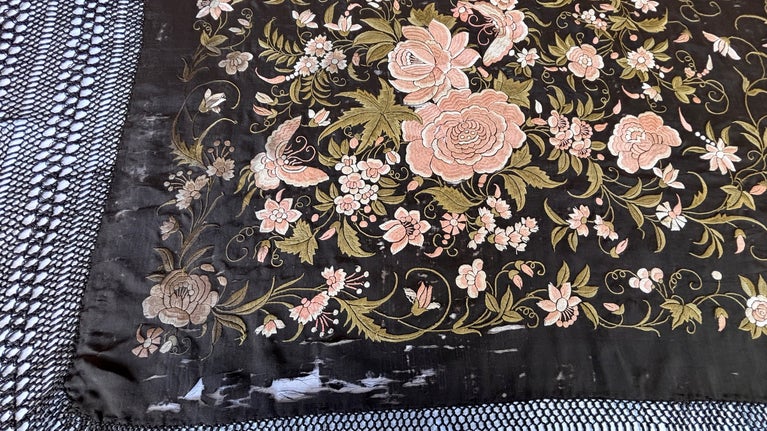Restoring Virginia Woolf's shawl

2025 marks the 100 year anniversary of the publication of Mrs Dalloway. We're taking this opportunity to celebrate the novel by fundraising to repair Virginia Woolf's shawl, recently identified as her only surviving piece of clothing. The shawl was removed from display in 2023 due to it's extreme fragility.
Background
For Christmas 1933 Ottoline Morrell, the famous society hostess and patron of the arts, gifted Virginia Woolf a shawl. Ottoline was prone to gifting shawls as they featured heavily in her own wardrobe.
‘It is indeed a damnably difficult thing to live fully, richly, gorgeously and yet courageously. To live on the grand scale.’
Ottoline Morrell, Journal, March 1927
Over the course of many years, Ottoline gifted shawls to many of her acquaintance, most famously Katherine Mansfield. So cherished was that gift that it was placed over Mansfield's coffin when she succumbed to illness in 1923.
If ever an item helps conjure an ethos, this lovely description of the use of shawls at a party attended by many of the Bloomsbury Group at Garsington, does just that;
When the guests were having their coffee in the Red Room, Philip went to the pianola and began to play one of the Hungarian dances. ‘Soon the party drifted out to the lawn: there was a full moon, stars in a great still sky and the dark ilex tree brooding like an ancient god. The music floated, powerful and alluring, through the open windows, its rhythm pulsating; one after the other, the guests obeyed the compulsion … shawls became wings, smoking jackets and ties abandoned to a strange frenzy of leaps and dances by the light of the moon.’ Miranda Seymour, Life on a Grand Scale.
And so to our shawl, so special as the only surviving item of clothing belonging to Virginia Woolf.
Monks House, Rodmell, 31 Dec 1933 Letter from Virginia Woolf to Ottoline Morrell
'Dearest Ottoline, You are a wonderful woman—for many reasons; but specially for sending a present—a lovely original wild and yet useful present—which arrived on Christmas day. I love being ‘remembered’ as they say; and I hung it on a chair, when the Keynes’s lunched here, and boasted, how you had given it me. What a snob I am aren’t I! But I cant help it. It was a very nice Christmas, as it happened; I had my shawl, and the turkey was large enough and we had cream, and lots of coloured fruits, and sat and gorged—Maynard Lydia Leonard and I.'
Condition and aims of the project
As described by Virginia in her thank you letter to Ottoline the shawl has been displayed for many years over the back of a wooden chair in Virginia Woolf’s bedroom at Monk's House. It is now in such poor condition and should not be returned to display without treatment.
The colour change in the silk from black to brown suggests that the silk is now inherently weak throughout. One corner of the shawl appears stained darker brown over the embroidery - some kind of water damage, spillage, or dye bleed. Further testing is required to identify the source of the stain.
The embroidery also appears to have lost its vibrancy and suffered severe colour change, this is more visible on one side where the colours are more muted, possibly due to variable light damage and the items' age.
The embroidery itself seems to be in a stable structural condition but there are a few losses or loose threads.
More importantly, there are splits in the silk within the embroidered motifs where stitching is starting or finishing, especially to the petals. The silk is starting to split around previous conservation stitching and in between areas of stitching suggesting that it has got progressively worse in condition over time.
The weight of the embroidery is not being carried by the support fabric which was applied 20 years ago in a previous attempt to extend the life of the shawl.
Treatment proposal:
- Thorough examination and documentation - handling is particularly difficult due to object size and length of fringe.
- Test stain removal for area of grey/black discolouration at the corner.
- Very careful vacuum suction to remove particulate soiling - this will have to be done through a screen.
- Reduce staining to corner
- Preparation of work areas and help with handling.
- Preparation of support fabrics; net and silk.
- Dyeing; net and silk
- Trial stitching to decide whether to work couching and fixing lines through to the additional silk support OR just work couching through the existing Stabiltex layer and the fixing lines through to the silk support.
- Pin and baste the shawl onto the support silk fabric layer.
Note: The value of this additional layer is to add stability which will strengthen the object and prevent too much strain being put on the conservation stitching. It will also provide visual infill to the areas of loss.
- Conservation stitching i.e couching adding to existing treatment.
- Fixing lines stitching.
- Turning and finishing edges.
- Netting.
- Support/repair of fringe.
- Untangling fringe.
- Mounting for display.
- Packing.
- Photography/documentation/final report.
We feel confident that with the addition of a silk lining and carefully considered stitching the planned conservation will strengthen and improve the longevity of the textile, thus slowing its deterioration.
In total almost 400 hours of conservation work is required to this shawl at a cost of £26 000.
Donate now to help us repair the shawl
This year we are fundraising for the repair of Virginia Woolf's only surviving piece of clothing; a shawl gifted to her by Lady Ottoline Morrell in 1933.
Will pay for conservator time to repair the fragile silk